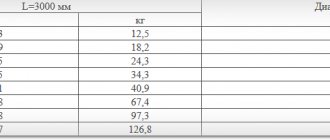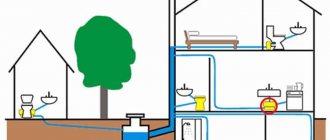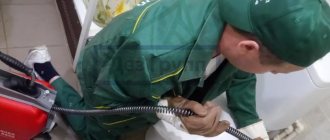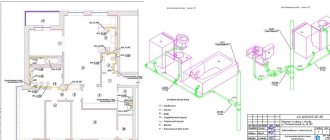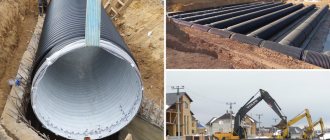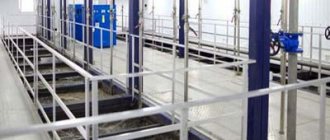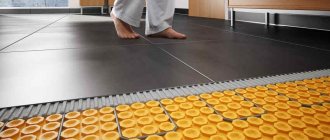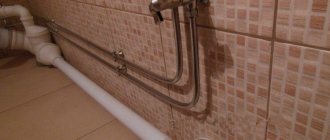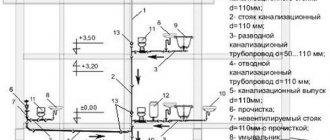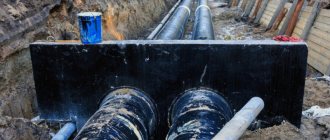Michel
6790 0 0
Michel July 20, 2016Specialization: plumber with 10 years of experience, computer repair specialist, powerlifting coach. I have extensive experience in construction, interior decoration, and making homemade furniture. Hobbies: sports
No one will argue with the fact that silent sewerage is an urgent need, and not just a whim of your heightened hearing. The sound of water flushing from a neighbor's toilet is not the best accompaniment for any apartment, especially since everything was different before the major renovation. Does this sound familiar to you?
You can rest assured that with such a pipe, your neighbors’ toilet schedule will soon cease to be a secret for you.
Principles of designing a low-noise system
Of course, silent domestic sewerage does not become so only due to the replacement of conventional main lines with lines made of silent pipes. This option is one of several that can be used to combat unwanted sounds.
If you insulate a standard sewer pipeline with sound-absorbing material and replace rigid supports with fasteners with a soft insert, you can already get a good result.
Considering that it is difficult and expensive to completely remodel an existing sewer system, it is reasonable to limit ourselves to the creation of insulating boxes. In combination with an insulating material, this approach will have a double effect.
The push-on sewer coupling is used to connect two plastic pipes according to the socketless principle. Structurally, the slip-on coupling is designed to compensate for shifts caused by thermal expansion
If you are installing a sewer system from scratch, then you should carefully approach the installation procedure. Correct installation, work with shaped elements - these criteria also give a good effect of silence during the future operation of the system.
Option #1: socketless connection
For example, it is recommended to connect socketless pipes to each other as follows:
- Align the cut ends of polypropylene pipes (cut angle 90º) and remove burrs.
- Use a sewer coupling as a fitting.
- Remove the sealing collars from the inside of the slip-on coupling and place them on the pipe nozzles.
- Apply water-based lubricant to the sealing collars.
- Insert the pipes (applying some force) inside the coupling until they stop.
The same principle is used for socket joints of pipes, connections with tees and corner fittings. In this case, in most cases of socket installation, the creation of thermal expansion compensators is taken into account.
Option #2: socket connection
Connections of pipes and fittings made without the use of a push-on coupling, installed on a pipeline section up to 3 meters in length (horizontal section), require compensation for thermal expansion.
That is, during installation, it is necessary to remove the pipe back by 10 mm after inserting it into the socket until it stops. The effect of thermal expansion can only be ignored in diagrams of socket connections between fittings.
A fragment of a sewer riser diagram, on the line of which a socket connection is used. The standard arrangement of fastening clamps (rigid and floating fixation) is shown. With this arrangement of fasteners, optimal noise characteristics are achieved
Method for creating a socket connection:
- Clean the pipe, the inside of the socket, and the area of the sealing ring from dirt.
- Make sure that the fit of the bell O-ring meets the installation requirements (no twisting, damage, or dents).
- Apply water-based lubricant to the pipe fitting.
- Insert the pipe all the way into the socket and then push it back 10 mm.
- Install a fastening clamp near the connection point.
Separately, it is worth considering the method of fastening silent sewer pipes (for example, Skolan brand). Here, the pipelines must be laid in such a way as to eliminate physical stress and the possibility of linear expansion.
The now popular polymer sewer pipes can be secured with standard clamps, but under the hoop of the clamp you should definitely use pads based on profile rubber.
A fragment of a sewer riser diagram showing how fastening clamps (sliding and fixed fixation) are located on a section of pipe without fittings
Recommended principles for mounting clamps:
- On a horizontal line, the distance between the clamps is equal to 10 times the pipe diameter.
- On a vertical line, the distance between clamps is no more than 2 meters.
- On risers, it is mandatory to install rigid and floating fastenings with clamps.
- Rigid fastenings on socketless pipes are installed above the fitting in the area of the lower pipe.
- Floating clamp fastening is achieved by partially tightening the lag screws.
- The floating mount is installed next to the rigid fastener on the side of the pipe inserted into the socket.
Provided that the noted principles are followed when installing a sewer system, it is possible to obtain acceptable noise characteristics of domestic sewerage at a level of 12-20 dB.
Description
The pipeline, which dampens the sound of flowing liquid, is made from traditional materials in combination with substances that absorb sound vibrations. Low-noise internal sewerage has the following structure:
- Hard polyethylene layer.
- Mineralized polypropylene.
- Soft layer made of polyvinyl chloride.
Several layers are able to dampen noise from flowing sewer liquids to a level that meets European standards.
An essential part of a silent sewer system is a special support clamp. This part is designed to fix polymer pipes to the base. The clamp is made in the form of a metal hoop with a soft polymer insert that can dampen mechanical vibrations.
Installation details that affect noise levels
Under no circumstances should machine oils or similar lubricants be used as a lubricant for connection elements. All of them have a negative impact on the structure of rubber seals.
Rubber loses its technical properties, cracks and structural irregularities appear on the seals. Such a compaction not only becomes a source of increased noise, but also threatens to burst at any moment.
The connection of polypropylene pipes is preceded by lubrication of the areas directly involved in the contact. A specialized water-based gel (lubricant) is used as a lubricant.
It must be remembered that connections “straight pipe - socket” are always installed taking into account the installation of the edge of the socket against the flow of waste. Under such conditions, maximum smoothness of the internal surface of the sewer line is ensured, which in turn is accompanied by a low flow noise level.
The noise characteristics of the sewerage system are also affected by the slope of the pipes. It is not recommended to deviate from established standards and norms that determine the amount of slope depending on the diameter of the sewer hose.
For pipes with a diameter of up to 50 mm, the slope value is no more than 35 mm; for diameters from 50 to 100 mm, a slope of no more than 20 mm is recommended. Pipelines with a diameter of 150 mm or more are installed with a slope of no more than 8 mm.
Turns of pipeline lines, as well as branches, are made by installing oblique tees or half bends (angles 30-45º). The principle of constructing networks in this way helps reduce sewer noise.
The effect of noise suppression during volley discharges into the sewer system is especially noticeable. In addition, the smooth bends of the turns create better conditions in case of cleaning the system with a sewer cable.
The correct (incorrect) execution of turns in the domestic sewage system is one of those factors that influences the increase (decrease) of noise. During installation, it is recommended to adhere to the technique of creating smooth turns and bends
Plastic pipelines on straight horizontal sections should be fixed with clips, support clamps, and hangers every 7-9 meters. If you deviate from these requirements, there is a risk that after some time of operation you will end up with sagging areas in such areas.
Pipeline sagging is a change in the parameters of the movement of wastewater and, as a result, an increase in noise level. At socket joints, fastening is carried out by default.
"Silent" pipes
This is perhaps the most reliable and modern method of removing noise from the sewer system, but it is only available at the stage of installing a drainage system or its major repair.
Moreover, when installing sewerage systems in apartment buildings, such a system is effective only if it is used on at least two or three adjacent floors. The principle of “silent” pipes is the use of a multilayer structure of the pipe itself plus special noise-absorbing fasteners.
In our country, the Rehau Raupiano system is quite widely represented, which includes a wide variety of pipes of different diameters, lengths and purposes, connections for them and fastenings.
There are also Ostendorf, Waving and Politek (Russia) systems.
With the help of such “silent” products, home communications can be completely formed, as shown in the diagram below.
You can learn more about the features of pipe communications from the Rehau company from a video recording of a seminar dedicated specifically to silent sewerage.
Branded Low Noise Sewage Products
There are brands that have proven themselves to be of excellent quality and have a strong foothold in the domestic sewer products market.
Vavin Asto and ASTOLAN
In recent years, market offers have surprised us with a wide selection of branded silent sewage systems. Among the available examples for installation, we can note, for example, a product under the Vavin Asto brand.
The company manufactures and sells polypropylene pipes and fittings based on ASTOLAN, a material modified with mineral additives.
The low-noise sewer system produced by Wavin Asto (a set of pipes and fittings) is a ready-made solution that takes into account all the nuances of sound insulation. All that remains is to assemble the system in accordance with the instructions and enjoy the comfort
Thanks to the modification, engineers were able to increase the wall density of sewer pipes to 1.9 g/cm3 and enhance indicators such as viscosity and specific gravity. As a result, virtually silent sewage systems “Vavin Asto” appeared.
According to company representatives, there is no vibration noise during system operation. The penetration of sewer sounds through airspace is also excluded.
German quality Ostendorf
Another example of a modern noise-free system is sewerage based on pipes and fittings of the Ostendorf brand. The base material is the same, mineral-modified polypropylene.
But the density indicators in this case are somewhat inferior - 1.6 g/cm3. At the same time, the temperature parameters of the Ostendorf sewer system are higher - up to 100ºС, and pH values are in the range of 2-12.
The German company Ostendorf offers to use engineering solutions that guarantee silence in the house. German technologies for the manufacture of sewer pipes and fittings eliminate the occurrence of technical noise above established standards
characterized not only as low noise. All production elements are characterized by a high degree of corrosion resistance, durability, and resistance to aggressive environments. An extensive range of shaped parts and pipes ensures the creation of communications for various purposes.
Rehau and REHAU RAUPIANO Plus
Systems also show a high percentage of popularity. In particular, the product REHAU RAUPIANO Plus is persistently advertised. The technological approach, however, is not much different from the two previous firms.
In the fight against noise, Rehau also places emphasis on the production of multilayer plastic pipes, on reinforcing the wall thickness of corner fittings, and on the production of so-called “noise-absorbing” clamps.
Parts for the installation of a domestic sewage system, produced under the Rehau brand, are made taking into account effective sound insulation. Sewage installation based on Rehau parts promises a quiet life
The practice of operating such a sewer system shows a noise reduction of approximately 25-30%. If desired, similar indicators can be achieved if standard work on sound insulation of a domestic sewage system is performed using available insulating materials.
The following article, which contains a lot of useful information, will introduce you to guidelines for choosing the best pipes for installing an internal sewer system.
Why is it noisy?
The concept of “quiet” sewerage also arose because today many people in their apartments have plastic - reliable, but at the same time very noisy - risers, which do not allow residents of apartments in multi-storey buildings to live in peace. Sewage and water pass through these pipes so clearly that it seems that this water is about to end up right in your apartment.
Why is this happening?
This has never happened before.
From the point of view of acoustic vibrations, any hollow pipe is an ideal waveguide: constantly reflecting from the walls, with minimal loss of amplitude, sound can travel quite long distances.
But this is in the pipe, and outside it?
In order for sound to spread beyond the pipe, which is what we are actually observing, a combination of two factors is necessary:
- Pipe masses . It should be insignificant, otherwise the power of the acoustic vibration is simply not enough to make the walls resonate;
- Strong pipe walls. Plastic has everything in order - both high density and solid structure.
Relatively recently, this problem was not relevant at all due to the fact that all pipelines in multi-story buildings were made of cast iron, which made all sounds and processes taking place inside these pipes inaudible.
Despite the excellent sound insulation of cast iron systems, this factor today is their only advantage.
Cast iron riser. It looks quite rough, is installed firmly and operates quietly.
The fact is that there are many reasons why users prefer plastic pipes. Let's look at the properties of two similar materials and identify all their advantages and disadvantages.
| Cast iron | Plastic |
| Cast iron pipes weigh a lot and are very difficult to transport and install. | Plastic pipes are lightweight, and working with parts made from the presented material is very simple. |
| The fittings and pipes are susceptible to corrosion, which means that their optimal service life is not as long as we would like. | The presented material does not corrode, does not rot, and, very importantly, does not rust, thus it is the best option for pipes, because the service life of such material is really long. |
| Installation and dismantling of such pipes is extremely difficult. | The system under consideration is very easy to both assemble into a single structure and disassemble into individual parts. |
From all of the above, we can draw an unambiguous conclusion - a system made of PVC pipes has more advantages, and therefore is more expedient, than pipes made of cast iron.
But, as in any other case, not everything is as smooth as we would like, and there are some disadvantages here. In this case, the disadvantage of plastic pipes is the lack of sound insulation, which makes their operation not entirely convenient .
The victory of plastic over cast iron no longer seems so significant.
Let's take a closer look at how such a small but significant disadvantage can be eliminated with your own hands and without extra costs. Let's start with an overview of each of the available methods.
Conclusions and useful video on the topic
Some useful tips on how to reduce the noise level of the sewer system and make your life more comfortable.
The installation of a low-noise sewer system is possible, as evidenced by numerous proposals in the plumbing industry. Meanwhile, problems with noise parameters of drains practically did not exist as long as good old cast iron pipes were used.
As soon as lightweight and inexpensive polypropylene came into use, problems with silence in the house arose. There is something to think about for both plastic manufacturers and residential building owners.
Please write comments in the block below. Tell us about how you built a silent sewer system in your own house/apartment, or about technological nuances not covered in the article. Ask questions, share useful information, post photos on the topic.
Sequence of work
The entrance and main exit, interfloor partitions and ceiling areas are treated with a soundproofing compound. In order for the process to be carried out correctly, the free space near the pipes and in those places where they must pass through or the ceiling is calculated.
Afterwards, a suitable rubber cuff is selected. The main thing is to pay attention to the consistency of the diameter. If it is not possible to buy such a cuff, the pipe exit area is sealed with polyurethane foam. Next comes the installation of fasteners. To ensure that the structure is securely fastened and does not wobble from the water flow, fasteners and a clamp with rubber gaskets are used.
The next stage is the creation of a soundproof shell and the closing of the structure that we talked about. Also, don’t forget about eliminating odors.
Building a silent sewer system is not difficult. There are several main ways to solve the problem. Isolate a ready-made system with silent elements or equip it from scratch. The second option is more effective. With the help of additional materials, installation is carried out on your own and does not take much time.
Currently reading
- We select the diameter of polypropylene pipes ourselves
- Three ways to lay pipes in the toilet and bathroom
- Seven rules for closing toilet pipes from prying eyes
- Overview of the operation of end caps for all types of pipes
Sewer riser
Many people are interested in how to soundproof a sewer riser. This is where the most noise comes from.
And the noise it creates in the apartment is conventionally divided into:
- Shock. It is created from the interaction of the fluid flow with the walls of the pipes. It is not at all possible to get rid of it, but it is quite possible to reduce it.
- Air. This is the sound from the air through which the flow of water passes.
- Structural. Appears after vibration of pipe materials and network elements that come into contact with each other.
It is the third type that we have to fight, as it creates the most serious problem.
To make sound insulation with your own hands you need:
- prepare the material and cut out a piece from it that will correspond to the dimensions of the riser circumference.
- Secure this part with construction tape. It is important that the edges are positioned end to end. Placing them in any other way will reduce efficiency.
- It is recommended to fasten soundproofing coverings for sewerage tightly, using the addition of several layers. This increases the weight of the structure and reduces resonance. As a result of these actions, structural sounds become less noticeable.
- If the need arises, a decorative box can be constructed around the sewer riser. This also has a positive effect on sound insulation in this situation.
Sound-absorbing materials
To reduce noise levels, a wide range of high-quality materials are available on the market: • Soundproofing tape
. The material is made of polyethylene foam and has an adhesive layer on one side. Thanks to this, it can be easily and conveniently attached to any vertical and horizontal surfaces. Soundproofing tape is resistant to corrosion processes, does not collapse under the influence of high temperatures, protects against moisture and reliably prevents the spread of noise through connecting elements;
• Soundproofing membrane
, which is made from polymer and natural components. It is characterized by great flexibility, high strength and durability. The principle of operation of a soundproofing membrane is to create a protective barrier around the pipeline that reflects the sound wave;
• Sound insulation with aluminum foil
, which can provide high noise insulation even with small thickness. The first layer of material absorbs sound waves, and the second reflects. Experts use various materials in their practice. Their choice depends primarily on characteristics, soundproofing effect, cost and installation method.
PRELIMINARY STUDIES
To install an autonomous sewer system, it is necessary to first draw up a diagram of the location of all points of water intake and drainage. The location of the water supply point for the house and the entire yard with clean water should be marked as accurately as possible.
Note! We remember that a cesspool or other sewerage device should not be installed near a natural source. The site's sewage system consists of:
The site's sewage system consists of:
- Part of the system that integrates plumbing fixtures in a building and is located inside the structure.
- Sewage pipes that carry wastewater from the house to the outside of the system.
- Storage facilities located on the site in which wastewater is treated and released into the soil or settled for further removal.
Note! If necessary, summer showers, toilets, and baths located on the site must be included in the sewage system of the entire site and must be indicated on the drawn up diagram
- Location of a well or well with drinking water.
- Groundwater level at the site.
- Soil freezing depth.
- Type of soil and its condition.
All soil data can be obtained from a geodetic survey during the preparation of a construction project. If you don’t have such documents, talk to your dacha neighbors and they will tell you a lot of interesting things. By asking just a few questions, you will find out what kind of sewer system is used in neighboring areas, what is good and bad about it. When developing, take into account the information received.
The type of soil on the site particularly influences the choice of wastewater treatment facilities. Light soils, which are dominated by sand, allow moisture to pass through well. Sewage passing through such soil easily reaches the groundwater level, which leads to its pollution.
Soils containing large amounts of clay do not drain water well. A cesspool without a bottom built on such soils will quickly silt up. When choosing treatment facilities, you also need to take into account the level of the aquifer. Treatment facilities and the well are located at a distance of at least 6–10 m from each other.
Sewage pipes must be laid below the freezing level of the soil. The scheme is drawn up in such a way that the water supply pipes do not intersect with the sewer pipes.
Note! There is no point in connecting a washbasin installed outdoors to the general sewer system. Dig a small hole and fill the bottom with crushed stone or gravel
Make a drain from the washbasin into this hole. For a small amount of water, such a structure is quite enough.
The sewer system at each site is developed individually and the choice of its type can also be different, even if many factors coincide. In sewer systems, it is mainly the treatment facilities that differ.
Let's look at the construction of three options:
- A simple cesspool.
- Modern construction - septic tank.
- Local treatment station.
Purpose
The noise a sewer pipe makes during operation can exceed 67 decibels, about the level of a scream. Many owners put up with such noisy neighbors or, being them, try not to use sewer systems at night (simply not to flush). But such a life is unlikely to be comfortable. It is to avoid such problems that sound insulation is necessary.
There are several reasons why the sewer system is noisy:
- The sound of water when draining. Most often found in metal plumbing structures;
- Broken tank. If this part of the sewer system is in good working order, then the sound should not exceed 40 dB, but if it breaks down, the mechanical parts can emit loud sounds during operation;
- Poor sealing. Air gets into the drains; when the water supply system is running, it makes noise like ventilation;
- Incorrect sewer angle. This is the most common reason. The sharper the angle, the louder the water will flow through the pipes. If your pipe is located at a very high angle, then the waste water will simply fall into the main line, causing loud, knocking sounds.
A lot depends on the material. Cast iron pipes, due to their density and high wall thickness, are considered the quietest of all metal pipes. But they are overgrown from the inside with minerals and waste. Manufacturers of plastic communications claim that polypropylene and polyethylene are also quiet, but this is not entirely true. In such pipelines, shock and sharp noises are often encountered.
Photo: quiet cast iron pipe
When choosing plastic pipes for sewerage, immediately look for silent options. This is, for example, the OSTENDORF brand and other polypropylene communications with a special noise-absorbing layer. They do not allow sound to pass through and are immediately sold with thermal insulation.
Silent pipes
Fastening drainage lines
The pipes are secured using special clamps. If plastic pipes are used to drain recycled water, it is necessary to place the fasteners evenly along the entire length of the device, approximately every 0.5-1 m.
To fasten risers with a diameter of 100-110 mm, steel brackets with a bend at the end are used, which prevents the pipeline from moving under water pressure.
Brackets must be placed under each outlet pipe near the socket.
The correct placement of brackets on the sewer riser can be seen in the figure:
Placing brackets on a sewer riser
To secure the riser to the side walls, 1-2 clamps are used per floor of the building.


